Quotations
Thoughts for us
Penetrating so many secrets, we cease to believe in the unknowable
But there it sits nevertheless, licking its chops.
H. L. Mencken

Heat Transfer in Nanoelectronics
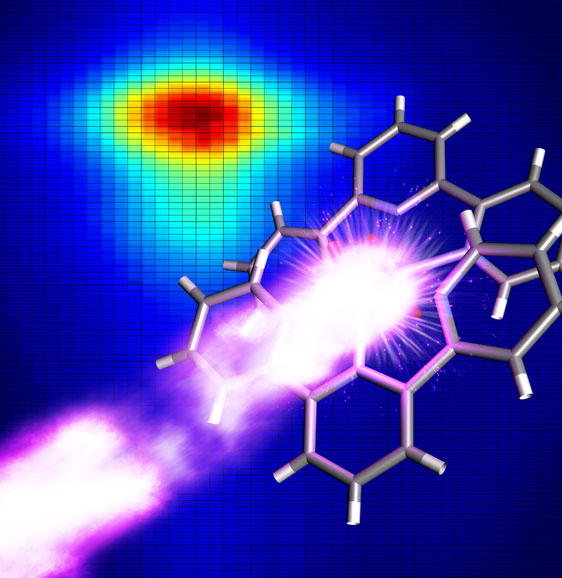
The
transient Fourier heat conduction equation of classical physics has
served well in the thermal management of conventional electronics
using commercial finite element (FE) programs such as ANSYS and
COMSOL. However, heat transfer in nanoelectronics is governed by QM
and not classical physics, QM stands for quantum mechanics. The
peculiarity of QM is that the heat capacity of the circuit element
vanishes. Joule heat is no longer conserved by an increase in
temperature. Instead, conservation proceeds by the QED induced
frequency up-conversion of Joule heat to non-thermal EM radiation.
QED stands for quantum electrodynamics.
The EM radiation
emitted from the nanostructure above is not thermal radiation, but
rather non-thermal QED induced radiation that is a consequence of the
vanishing heat capacity of the atom at the nanoscale by QM..
Commercial FE programs based on classical physics that assume the
atom has heat capacity are not valid for heat transfer of
nanoelectronics.
Nevertheless, thermal management of
nanoelectronics is proposed to proceed based on the time dependent
Fourier equation in standard 3D FE programs such as ANSYS and COMSOL
using thermal simulations for macroscopic circuit boards, cooling
systems, and surroundings. However, FE models of the nanoscopic
circuit elements invalid by QM may be simulated as point or line
sources of QED radiation. The QED radiation emission upon absorption
elsewhere may create hot spots in the nanoelectronics, but even this
is unlikely because QED radiation is dissipated over large areas.
Instead, management of space charge to minimize electronic noise is
expected to control the design of nanoelectronics. See Paper
and Presentation

MicroTherm 2013 allows people involved in solving thermal problems in electronics to meet and to present their ideas and achievements in the field of thermal management. The scope of the Conference covers the subjects connected with extreme temperature, electronics, sensors and measurement techniques, modelling, simulation, wide band-gap materials, packaging and reliability, renewable energy sources and photonics with special emphasis on microelectronic technologies.
In microelectronics, heat transfer in circuit elements having dimenisons greater than 1 micron proceeds by classical physics that allows the atom to have heat capcity to conserve Joule heat by an increase in temperature, the analysis of which uses commercial finite element programs such as ANSYS and COMSOL. However, nanoelectronics having dimensions less than 1 micron differs in that QM precludes the atom form having the heat capacity to conserve Joule heat by an increase in temperature. Instead, conservation proceeds by the QED induced conversion of Joule heat to excitons (hole and electron pairs) that charge the circuit element or upon recombiantion emit EM radiation to the surroundings. QM stands for quantum mechanics, QED for quantum electrodynamics, and EM for electromagnetic. Paradoxically, classical physics by allowing the atom to have heat capacity to conserve Joule heat by an increase temperature does not create the charge necessary to change the resistance of the circuit element. See Paper and Presentation

Sizes of MEMS electronic devices range from 20 to 1000 microns. MEMS stand for micro-electro-mechanical-systems. Heat transfer in MEMS proceeds on the classical assumption the atom has heat capacity to conserve absorbed EM energy by an increase in temperature. EM stands for electromagnetic. In contrast, NEMS describes devices having sizes < 100 nm. NEMS stands for nano-electro-mechanical-systems. In NEMS devices, heat transfer by the Fourier equation of classical physics that assumes the atom has heat capacity is no longer valid, and instead QM is required. QM stands for quantum mechanics. QM requires the heat capacity of the atom to vanish and therefore any form of EM energy, say Joule heat absorbed in the NEMS device cannot be conserved by the usual increase in temperature. Instead, conservation proceeds by the creation of QED induced radiation that produces excitons and although avoiding hot spot temperatures, the NEMS circuit element is charged and generates 1/f noise. QED stands for quantum electrodynamics. By contrast, MEMS devices do indeed increase in temperature under Joule heat but do not create charge. In this arrangement, electronic circuit element design is optimum in the MEMS/NEMS transition region from 20 microns to 100 nm offering the advantage of both avoiding hot spots and 1/f noise. See Paper

Fourier’s transient heat conduction equation has served well in the heat transfer of conventional electronics. However, unphysical findings in the applications of Fourier’s equation to the heat transfer of nanoelectronics having sub-micron circuit elements have suggested Fourier’s equation needs to be modified. In this regard, the Fourier’s equation is modified for nanoelectronics by imposing vanishing heat capacity as required by QM in combination with the conservation of Joule heat by frequency up-conversion to the total internal reflection resonance of the circuit element by QED, the consequence of which is Joule heat is dissipated by the creation of excitons (Holon and electron pairs). QM stands for quantum mechanics and QED for quantum electrodynamics. The holons charge the circuit element as the electrons escape to the surroundings or upon recombination EM radiation is emitted to the surroundings.
At IEEE Nano 2013, a contrarian view that spin-valves have nothing to do with electron-spin, and instead the GMR is reduced by QED induced photoconductivity from the dramatic increase in the number of excitons created in the nanoscale ferromagnetic layers. Indeed, reduction of the GMR by spin is relatively insiginificant compared to QED induced photoconductivity. Nanoelectronics circuit elements comprising memristors, PC-RAM, and 1/f noise are briefly summarized. Paper , Digest , and Presentation

The 2013 Nobel was awarded to Martin Karplus, Michael Levitt and Arieh Warshel for their development of simplified MD methods to simulate the behavior of molecules at various scales, from small molecules to the large proteins in drug design. However, the 2013 Nobel actually recognizes the field of computational chemistry itself rather than particular individuals and certainly was not awarded for the discovery that simplified MD reduces computational resources. In retrospect, the Nobel committee could have selected more prominent MD computational scientists like William Goddard and Michele Parrinello, but did not. In effect, the 2013 Chemistry Nobel was implicitly awarded to every computational scientist who simplifies MD.
Laureates Karplus, Levitt, and Warshel combined QM with classical statistical mechanics to simulate molecular motion using simplified force-field models for various energy dependencies as shown in the thumbnail. But this is not unusual as the MD community knows full well simplified methods are always required to limit computational costs. However, the simplified MD approach still requires experimental data and supporting QM calculations, and may need to be repeated many times perhaps taking as much overall time as the full QM solution.
The 2013 Nobel directed to simplifying MD in the field of computational chemistry by a combination of classical physics and QM although valid for the continuum does not address the validity of the MD solutions for discrete molecules or nanostructures. Unlike classical physics implicit in MD, the problem is QM requires the heat capacity of the atoms in discrete molecules or nanostructures to vanish, and therefore the thermal kT energy of the atoms cannot be related to their momenta. Here k stands for Boltzmann's constant and T for absolute temperature. Alternatively, if the simplified MD simulation is made according to the 2013 Nobel award, the MD solution is still invalid by QM.
The 2013 Nobel committee is to be congratulated for awarding the prize in Chemistry to the collective efforts of the computational chemistry and physics community for simplifying MD computations, but does not go far enough. Simplified MD models alone do not produce valid MD solutions unless QED radiation created by QM is included in the simulations. In this regard, the Nobel falls short of reconciling the invalidity of the uncountable number of discrete MD simulations in the literature, but more importantly fails to provide the guidance going forward to obtain valid MD solutions. See Press Release
4th ASME Micro/Nanoscale Heat & Mass Transfer
International Conference (MNHMT-13)
The University of Hong Kong, Hong Kong, China
11-14 December 2013

The Fourier Law at Macro and Nanoscales
The Fourier law implicitly assumes transient thermal disturbances are carried throughout the solid at an infinite velocity while avoiding the mechanism that carries the heat. Paradoxically, phonons and electrons on which the Fourier law is based are limited to acoustic velocities. The paradox is resolved by thermal BB radiation photons finding basis in the harmonic oscillator of Planck’s theory of QM. BB stands for blackbody and QM for quantum mechanics. Instead of carrying the heat of the disturbance, the BB photons created by the atoms carry the temperature of the disturbance throughout the solid at the speed of light, and therefore provide a reasonable approximation to the Fourier law that assumes an infinite carrier velocity, thereby allowing the temperature of atoms at the disturbance as well as the temperature of all other atoms to be instantaneously known everywhere in the solid. The Fourier solution of the transient response of the semi-infinite solid is shown to be virtually identical to that which includes the lag time caused by the speed of light. By QM, thermal BB photons not only explain the success of the Fourier law in describing thermal conduction at the macroscale, but also its failure to do the same at the nanoscale. See Paper and Presentation
Near-field Radiation by Quantum Mechanics
The Planck theory of blackbody radiation giving the dispersion of photons with temperature has served well in the radiative heat transfer between surfaces at the macroscale. Recently, near-field heat transfer by evanescent waves in nanoscale gaps based on solutions of Maxwell’s equation is claimed to exceed by 3-4 orders of magnitude the heat transfer given by Planck theory. However, the Maxwell solutions are questionable because QM precludes the atoms in the surfaces adjacent the gap surfaces under EM confinement `from having the heat capacity to allow the temperature fluctuations necessary to satisfy the FDT. QM stands for quantum mechanics, EM for electromagnetic, and FDT for fluctuation dissipation theorem. Analysis is presented that shows bulk temperatures far removed from the gap do not exist at the gap surfaces, and in fact the temperature differences across gap surfaces tend to vanish. Hence, the Maxwell solutions that assume bulk temperatures abruptly change across gap surfaces over-predict the enhancement of near-field heat transfer by evanescent waves. Instead of evanescent waves, heat is transferred across the gaps between bodies by QED induced tunneling of EM radiation thereby allowing Planck theory to remain valid without modification for nanoscale gaps. QED stands for quantum electrodynamics.
Claims near-field heat transfer is experimentally verified may be safely dismissed because of the abrupt change in bulk temperatures assumed across the gap surfaces in interpreting the data. Similarly, Maxwell solutions that assume heat is transferred across gaps with surfaces coexisting at distinct and different bulk temperatures are consistent with classical physics, but not QM. Indeed, QM refutes the counter-intuitive conjecture that the heat transfer between bodies is actually highest at zero surface spacing. QM aside, it is unphysical to bring bodies to zero spacing without making thermal contact, and therefore it is unlikely any practical device utilizing nanoscale gaps can ever be fabricated to take advantage of the 3-4 orders of magnitude enhancement predicted by Maxwell’s equation for near-field heat transfer by evanescent waves. See Paper and Presentation
Quantum Mechanical Stiffening of Nanowires
Over the
past decade, the observation of significant stiffening of nanowires
or NW’s has been reported, although some findings suggest there is
no stiffening. Because of this uncertainty, research on the
mechanism for NW stiffening has been a subject of great interest.
Mechanisms that depend on high surface-to-volume ratio of NW’s
including surface stress and strain have been proposed to explain
stiffening, but cannot explain observations, e.g., NW’s in tensile
tests increase rather than decrease in diameter as expected by
the Poisson effect in classical elasticity theory. Like other
observations at the nanoscale, NW behavior in tensile testing cannot
be interpreted by classical physics.
QM differs by
precluding the atoms in NW’s from having the heat capacity to
conserve the absorption of EM energy by an increase in temperature.
QM stands for quantum mechanics and EM for electromagnetic. In
tensile tests, the temperature of the grips that hold the NW during
the tensile test do not increase the NW temperature. Instead,
the absorbed thermal energy is conserved by frequency up-conversion
to the TIR confinement frequency of the NW by QED. TIR stands for
total internal reflection and QED for quantum electrodynamics. Under
TIR confinement, QED converts the thermal energy into excitons
(holon and electron pairs) by the photoelectric effect, the
consequence of which is the atoms are charged producing a state of
hydrostatic repulsion within the NW. Molecular dynamics simulations
that exclude temperature changes consistent with QM show the
stiffening of NW’s is caused by the QED induced charge repulsion
between atoms. In this way, the usual uniaxial stress state is
changed to triaxial having a Poisson effect that increases the wire
diameter under tension and enhances the Young’s modulus of the NW.
Extensions show QED induced charge repulsion explains the NW
stiffening observed if the NW absorbs any form of EM energy -
electron beam irradiation or from the Joule heat produced by passing
current through NWs.
See Paper and Presentation
Validity of Molecular Dynamics by Quantum Mechanics
Molecular
Dynamics or MD is commonly used in computational heat transfer
to determine the heat transfer in nanostructures. With theoretical
basis in statistical mechanics, MD relates the thermal energy of the
atom to its momentum by the equipartition theorem. Momenta
of atoms in an ensemble are determined by solving Newton’s
equations with inter-atomic forces derived from Lennard-Jones
potentials. Statistical mechanics assumes the atom always has heat
capacity as otherwise the momenta of the atoms cannot be related to
their temperature. In heat transfer simulations of bulk materials, MD
simulates the continuum by imposing periodic boundary conditions on
an ensemble of atoms having heat capacity in submicron computation
boxes. MD simulations of the bulk are valid because atoms in the bulk
do indeed have heat capacity.
However, heat transfer in
nanostructures differs. Unlike the continuum, the atom confined in
discrete submicron geometries is precluded by QM from having the heat
capacity necessary to conserve absorbed EM energy by an increase in
temperature. QM stands for quantum mechanics and EM for
electromagnetic. MD is no longer valid as temperature cannot be
related to the atom momenta. Instead, conservation of absorbed EM
energy proceeds by the creation of QED induced non-thermal EM
radiation at the TIR resonance of the nanostructure. QED stands for
quantum electrodynamics and TIR for total internal reflection. The
QED induced EM radiation produces excitons (holon and electron pairs)
by the photoelectric effect that charge the nanostructure or are lost
to the surroundings – a conclusion that can only be reached through
QM as charge is not produced in statistical mechanics. What this
means is the uncountable number of MD solutions of discrete
nanostructures in the literature although well intended, have no
meaning. Examples of invalid discrete MD simulations from the
literature are presented including nanocars, linear motors, and
sputtering . In contrast, a valid MD simulation of stiffening of
nanowires in a uniaxial tensile test is presented. See Paper and Presentation
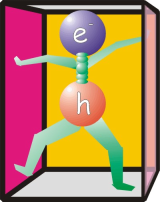
In nanoelectronics, light absorption is known to create excitons (holon and electron pairs) that separate under an electric field into free carriers that change the resistance of circuit elements. However, light absorption itself is not required as the Joule heat within the submicron circuit element may be induced by QED to create excitons. QED stands for quantum electrodynamics.
QED induced excitons find basis in the QM requirement that the heat capacity of the atom vanishes under TIR confinement. QM stands for quantum mechanics and TIR for total internal reflection. Lacking heat capacity, Joule heat cannot be conserved by an increase in temperature, and instead under TIR confinement the Joule heat is conserved by the QED induced creation of non-thermal EM radiation in the circumferential direction of the circuit element surface. EM stands for electromagnetic. In the manner of a quasi-bound state trapped in a potential well and leaking to the outside world by tunneling, the TIR confinement is temporary sustaining itself only during the absorption of Joule heat, thereby producing a momentary source of intense photoexcitation for the creation of QED induced excitons. Illustrations of QED induced excitons in resistive switching of memristors and spin-valves including extensions to the superconductivity of nanowires at ambient temperature are presented. See Paper

The Asian International Conference on Surfaces, Coatings and Nanostructured Materials (NANOSMAT-Asia) was held in Wuhan, China during 13-15 March 2013. Owing to the increasing level of participation in NANOSMAT by delegates from Asia, delegates from academia, industry and research institutes to network, exchange ideas and gain new insights on the forefront of materials, processing and nanotechnology related applications. Topics range from nanoelectronics to biomedical application, the combination of which is illustrated above in the QED induced neuron synapse. the highlight of NANOSMAT is the lecture by 2007 Nobel Laureate Peter Grunberg (Germany) on the future development of spin-valve. See Paper and Presentation
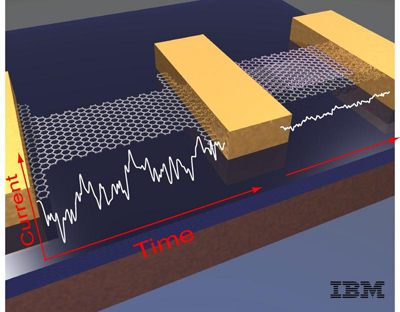
Graphene comprising 2-D sheets of single carbon atom monolayers is of great interest in field-effect transistors (FETs). Currently, the heat transfer analysis of Joule heating in FETs is derived with classical physics. However, QM differs by requiring the graphene to emit QED induced non-thermal EM radiation. QM stands for quantum mechanics and QED for quantum electrodynamics. Finding basis in the QM requirement that the heat capacity of the atom vanishes under TIR confinement at the nanoscale, Joule heat from passing current through FETs cannot be conserved by an increase in temperature. TIR stands for total internal reflection. Instead, conservation proceeds by the QED induced frequency up-conversion of the Joule heat within the FET to non-thermal EM radiation at the TIR confinement frequency of the carbon monolayer. EM stands for electromagnetic. However, the QED radiation emitted from the graphene is not included in the solution of the Fourier diffusion eqauation the consequence of which is the temperature of the graphene is thought to increase in excess of 1000 K instead of not increasing at all as required by QM.
Today, spatially resolved Raman spectroscopy based on the 2D-phonon band near 2700 /cm is used as a microscopic thermometer to infer the local temperature distribution in graphene FETs. However, the notion that effective temperatures may be inferred for a particular vibration mode has a long history of controversy showing the multi-phonon excitation of molecules is not equivalent to thermal heating. The problem with assigning an effective temperature to a particular vibration mode of a molecule is best explained by the difference between QM and statistical mechanics.
Statistical mechanics is applicable to the average vibrational temperature of a very large ensemble of molecules, but does not apply to the temperature of a single molecule itself. Indeed, QM precludes the individual molecule from having the heat capacity to conserve the absorption of EM energy by an increase in temperature, and instead conservation proceeds by dissipating absorbed EM energy by molecular vibrations. Because of this, the correlation between Raman shifts of graphene monolayer specimens in an oven to a controlled temperature is meaningless even if one sets aside the fact that graphene specimens at oven temperature are most likely not at the same temperature as those in FETs under Joule heating. See Press Release

The 4th International Conference on Ultrafine Grained and Nano-Structured Materials (UFGNSM) is to be held in Tehran, Iran on 5-6 November 2013. Setting politics aside, the scientific topic selected for discussion is the validity of MD in heat transfer of UFGNSM. MD stands for molecular dynamics.
In computational physics, MD is thought to provide a valid method to derive the atomistic heat transfer response of UFGNSM. MD finds basis in statistical mechanics that assumes atoms always have heat capacity. In the continuum, atoms do indeed have heat capacity, and therefore MD simulations of the continuum made by imposing periodic boundary conditions on an ensemble of atoms are therefore unequivocally valid.
Unlike the continuum, nanostructures comprise discrete ensembles of atoms that lack the periodicity necessary to allow the atom to have the heat capacity required by statistical mechanics. Instead, the heat capacity of the atom is given by QM depending on its EM confinement. QM stands for quantum mechanics and EM for electromagnetic. Nanostructures have high surface to volume ratios, and therefore absorbed EM energy is almost totally absorbed in their surfaces by TIR. TIR stands for total internal reflection. TIR provides EM confinement at short wavelengths shorter than optical frequencies, and therefore by QM the heat capacity of the atom vanishes. Lacking heat capacity, QED induces the absorbed EM energy to be conserved by up-conversion to EM radiation at the TIR frequency of the nanostructure. QED stands for quantum electrodynamics. The QED induced radiation creates excitons that charge the nanostructure or upon recombination are lost to the surroundings. EM confinement by TIR is not permanent, sustaining itself only during the absorption of EM energy. Absent EM energy absorption there is no TIR confinement and QED induced radiation is not created.
MD simulations of nanostructures based on statistical mechanics are therefore invalid by QM. Valid MD simulations require modifications of standard MD programs consistent with the QM requirement that the heat capacity of the atom vanishes. However, the nanotechnology community has been reluctant to accept the necessary MD modifications to obtain valid QM simulations, perhaps because ofthe mistake in unknowingly publishing the invalid MD simulations that abound the literature. Nanotechnology deserves a solid analytical foundation. In this regard, academia by promoting MD theory based on statistical mechanics needs to reconsider QM. Perhaps, QM modifications of MD will begin to be initiated in the newly reformist Iran. See Paper and Presentation

Cancer therapy without the side effect of DNA damage to normal tissue remains perhaps the greatest challenge to medicine. In PDT, NPs with or without non-specific photosensitizers are claimed to destroy cancer tumors upon irradiation with IR lasers. PDT stands for photodynamic therapy, NPs for nanoparticles, and IR for infrared. However, the side effect of PDT is DNA damage as the photosensitizer also binds to adjacent normal tissue cells.
Recently, PIT is claimed to avoid the side effects of DNA damage in PDT by selective destruction of cancer tumors. PIT stands for photoimmunotherapy. PIT differs from PDT by using MAb molecules instead of NPs. MAb stands for monoclonal antibody. MAb molecules bind to specific proteins on the cancer cell membrane. Upon activation by IR light, PIT is claimed to only destroy cancer cells having MAb bound to their cell surface. The PIT mechanism given for tumor necrosis is described by the rapid expansion of local water upon the formation of holes in the cancer cell membrane. However, the rapid expansion of water most certainly cannot proceed without DNA damage of adjacent normal tissue. DNA damage in PIT is not reported, but like PDT the cancer cells are not destroyed without DNA damage.
In normal tissue, DNA damage may occur by alkylating agents and ionizing EM radiation. But alkyl reactions also emit EM radiation, thereby allowing the hypothesis that genotoxicity may be reduced by agents that absorb ionizing UV radiation from the cancer itself. The hypothesis is supported by the fact chemotherapeutic drugs that destroy cancer tumors are also UV absorbers. However, the UV absorption spectrum of DNA is broadband, and therefore it is unlikely the DNA can never be not damaged by any combination of chemo-drugs. DNA damage to normal tissue must therefore occur evidenced by the recurrence of cancer after chemotherapy.
In this arrangement, NPT is proposed to protect the DNA by absorbing all UV radiation independent of its frequency spectrum. NPT stands for nanoparticle therapy. Unlike PDT that uses < 100 nm NPs to destroy cancer tumors, NPT does not destroy tumors, but rather absorbs all UV radiation by using > 300 nm NPs. NPT protects against DNA damage by QED inducing the red-shift of UV radiation irrespective of frequency to non-damaging IR radiation. QED stands for quantum electrodynamics. In this regard, NPs > 300 nm are therefore perfect UV absorbers. See Paper .
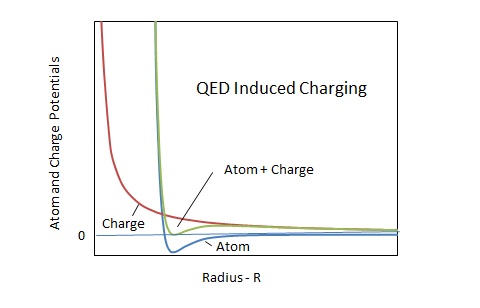
Driving
metal nanocrystals through nanotubes by electrical current is
commonly observed for crystals that can easily slide within the tube.
The mechanism by which the crystal moves is not well understood,
although generally thought to be electromigration whereby flowing
electrons transfer their momentum in collisions to the
atoms.
However,
What happens when the nanotube has a
constriction smaller than the crystal?
Obviously, the
constriction blocks the crystal motion. But experiments show an iron
crystal somehow slips through the constriction. Of course, if the
crystal is heated beyond its melting point and becomes a liquid it
could flow through the constriction. Or, if the crystal under high
electromigration force may undergo plastic deformation, the crystal
could be extruded through the constriction. However, temperatures are
near ambient and the electromigration force relatively low to
preclude extrusion, and therefore another mechanism is at play.
In
the alternative to electromigration, crystal motion is proposed
driven by charge created from EM radiation induced from the
conservation of Joule heat by QED. EM stands for electromagnetic and
QED for quantum electrodynamics. Conservation proceeds by the
creation of non-thermal EM radiation at the TIR resonant frequency of
the nanocrystal. TIR stands for total internal reflection. Lacking
heat capacity by QM, QED conserves the Joule heat at the TIR
frequency of the crystal by creating excitons (holon and electron
pairs) that charge the crystal or upon recombination are emitted as
EM radiation to the surroundings.
QED induced EM radiation
ionizes the iron atoms within the crystal at QM energies > 7.9 eV
liberating electrons and leaving the crystal highly charged. In fact,
the crystal undergoes a Coulomb explosion, although the atoms are
contained within the nanotube. In effect, QED induces the Joule heat
to charge the crystal to create a loosely bound state of atoms that
allows the crystal to easily slip through the constriction. However,
only a small fraction of the Joule heat is converted to a QED force
as almost all the Joule heat is lost as EM radiation to the
surroundings.
In the crystal, QM precludes conservation of
Joule heat by an increase in temperature, and instead charge is
created at the nanoscale that otherwise at the macroscale would
increase the atom temperature. QM stands for quantum mechanics.
The
amount of Joule heat necessary to create the charge necessary to just 'loosen' the atoms may be estimated by equating the L-J potential
having an attractive maximum energy epsilon at radius 2^1/6 sigma to
the repulsive Coulomb potential. L-J stands for Lennard-Jones and
(sigma, epsilon) are the L-J parameters for iron.
On the Plot
above, the L-J potential for the Fe atom (blue) has an attractive
maximum that when superposed with the charge potential (red) gives
the superposed(atom + charge) potential (green) having a vanishing
attractive potential. See
Press Release
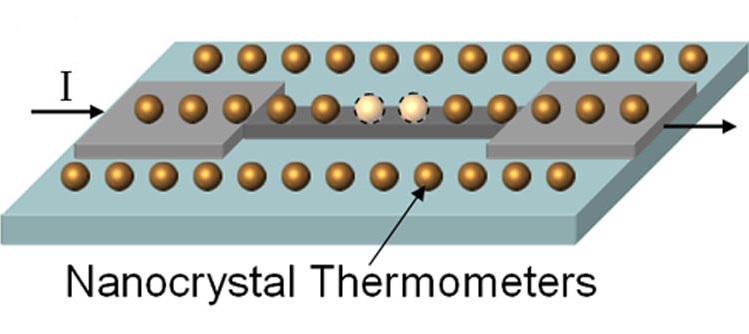
Measuring the thermal properties of nanoscale samples at any
temperature, let alone temperatures of 4000 K is, to say the least, quite
controversial. Nevertheless, claims have been made that a thermal test
platform is capable of operating at extreme temperatures as high as 4000 K
while allowing local temperatures to be inferred with nanoscale resolution.
The thermal test platform comprises a suspended Si3N4 membrane on which are
placed gold NPs that act as thermometers noted above as nano crystals. NP
stands for nanoparticle. Current is shown passing through the membrane provides
the Joule heat that is thought to create the extreme temperatures. Gold NPs
<10 nm are thought to allow local temperatures to be inferred because they evaporate
immediately upon melting, e.g., 6 nm NPs are considered to melt at 1275 K. In
measurements, temperatures at a point on the platform at the instant the
evaporating NPs disappear are inferred to be 1275 K.
However, claims the thermal platform allows the extreme temperature response of
nanoscale samples to be inferred from the evaporation of gold NPs may be safely
dismissed by QM. QM stands for quantum mechanics. Yet, the QM restrictions are
not limited to the instant thermal platform based on temperatures for the
vaporization of NPs, but rather more generally to the wide spread use of
classical physics in nanotechnology.
In classical physics, the heat capacity of the atom is constant at kT from the
macroscale to the nanoscale. Here, k is Boltzmann's constant and T absolute
temperature. The instant thermal platform that infers temperature from the
vaporization of gold NPs is therefore consistent with classical physics, but
unfortunately not QM. In fact, QM by the Einstein-Hopf relation for the atoms in
the NPs as harmonic oscillators requires the heat capacity to vanish. See Paper
"Zero Specific Heat"and Presentation here on page 2010.
At the nanoscale, heat may only be conserved by QED induced EM radiation. QED
stands for quantum electrodynamics and EM for electromagnetic. Indeed, absorbed
EM energy of any kind in a nanoscale sample cannot be conserved by an increase
in temperature because QM requires the atom to have vanishing heat capacity
under its own TIR confinement. TIR stands for total internal reflection.
Instead, conservation proceeds by the creation of non-thermal EM radiation at
the TIR resonant frequency of the nanoscale sample. Lacking heat capacity by
QM, QED conserves the Joule heat at the TIR frequency of the NP by creating
excitons (holon and electron pairs) that charge the NPs or upon recombination
are emitted to the surroundings as QED radiation.
What this means is there are no extreme temperatures that vaporize the NPs.
Instead, the NPs vaporize as the QED induced EM radiation ionizes the atoms to
produce a Coulomb explosion. See
Press Release
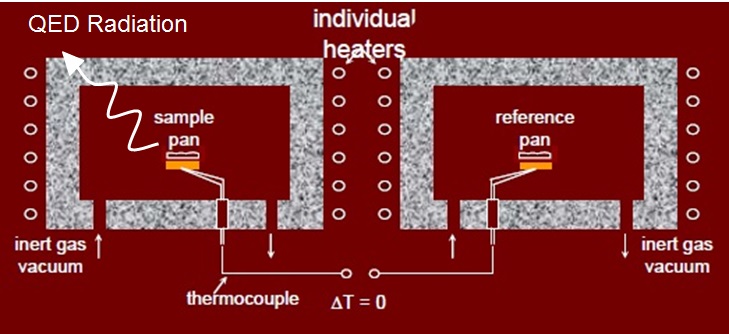
Historically,
the laws of thermodynamics are formulated on relationships among
quantities of free energy G, enthalpy H, and entropy S. Whether a
system may proceed from one state to another has been shown to depend
on changes ΔG, ΔH, and ΔS. However, over the past 30 years,
biological experiments of proteins have contrarily shown the laws of
thermodynamics need revision based on DSC measurements that show the
heat capacity Cp of proteins changes from folded to unfolded
conformations.
Generally, DSC is the accepted method to
obtain experimental ΔCp data between folded and unfolded protein
conformations. DSC stands for differential scanning calorimetry. In
DSC , the heat Q supplied to a sample protein and solvent in an open
or covered pan at a given temperature is measured and compared to
that of a reference of solvent only at the same temperature as shown
above.The DSC experiments show the protein has higher heat capacity
in the unfolded state than when folded. However, QM in the harmonic
region requires the heat capacity of the protein at ambient
temperature to vanish at conformations having frequencies higher than
the near IR. QM stands for quantum mechanics. Heat capacities in the
anharmonic region do not vanish, but protein conformations typically
vary only from the IR to the UV.Regardless, there should be no change
in heat capacity.
The problem is the DSC assumes the protein
follows classical physics in conserving heat Q and increases in
temperature, while instead the protein lacking heat capacity follows
QM and emits QED induced EM radiation. In the folded conformation,
the heat Q absorbed does not increase the temperature because in the
folded state the protein is a compact and nearly spherical shape
having a high TIR resonance in the UV. TIR stands for total internal
reflection. But the water solvent is transparent in the UV-VIS
window, and therefore the water temperature does not increase as heat
Q is not absorbed. Instead, the QED radiation emitted from the
protein is lost to he surroundings as depicted in the figure above.
Because the QED radiation in the UV is excluded from the heat
balance, the DSC shows the heat capacity Cp is lowest in the folded
state. In contrast, protein unfolding frequencies gradually decrease
from UV to the IR. Conversely, water having high absorption in the
IR, and therefore the heat Q is promptly conserved by increasing the
temperature of the water consistent with the unfolded state having
the highest heat capacity. See Press Release